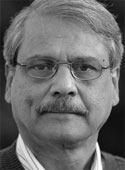The Demon We Created: The Emergence of Masood Azhar on the Pakistani Jihadi Scene Was Itself Quite a Thriller

By Zahid Hussain
January 20, 2015
IT took yet another militant attack across the border and increasing pressure from outside powers for us to finally act against Masood Azhar and his militant network — although one is not sure how serious we are in cleaning out the stables this time. Although proscribed some 14 years ago, his organisation continued to operate freely despite the evidence of its being involved in militant activities at home and outside.
How come a banned militant outfit was allowed to operate its offices across Punjab that the security agencies now claimed to have closed down? Has the province been in a state of denial, or is there something more sinister? The Punjab government had firmly dismissed the reports of expanding activities of groups earlier associated with Jaish-e-Mohammad. Masood Azhar lived in a well-protected compound in his hometown Bahawalpur.
Many believe that the Pathankot raid and the alleged involvement of JeM may constitute a tipping point.
The emergence of Masood Azhar on the Pakistani Jihadi scene was itself quite a thriller. Along with a group of reporters, I witnessed the unfolding drama of his release at Kandahar airport on Dec 31, 1999, in exchange for 155 passengers of an Indian Airlines flight hijacked by his supporters. The armed men had seized flight IC-814 after it took off from Kathmandu on a scheduled flight to New Delhi on Dec 24, 1999.
The eve of the new century brought an end to the hostages’ eight-day ordeal when the then Indian foreign minister Jaswant Singh arrived with the three men whose freedom was demanded by the hijackers. Among them was a short stocky man with an unkempt black beard. Masood Azhar was captured by the Indian authorities in 1994 and held in prison on terrorism charges.
Along with him was a tall, heavily built young man, a Pakistani-born British national, Ahmed Omar Saeed Sheikh. He had been detained in Delhi’s high-security Tihar prison for many years on charges of kidnapping three foreign tourists. It was the first time that a Pakistan-based religiously inspired militant group had successfully used hijacking as an instrument of terror.
Ironically, all those who had figured in the incident returned to haunt Pakistan with the turn of events a few years later. Sheikh was sentenced to death by a Pakistani anti-terrorism court for his involvement in the kidnapping and killing of American journalist Daniel Pearl in 2002.
In the first week of January 2000, Masood Azhar resurfaced in a Karachi mosque and addressed thousands of people who had gathered there. Surrounded by some two dozen men dressed in camouflage-style uniforms and brandishing automatic rifles, he triumphantly declared that he would not rest until he had destroyed America and India. Watching that spectacle, I remembered calling a senior official in Islamabad expressing my concern over his public appearance and his inflammatory speech. A few minutes later, the official called back with a message from the then ISI chief that I was ‘hallucinating’ and that it must be a recorded speech. One is not sure if the country’s top spymaster could be so clueless.
A few days later, Masood Azhar broke away from Harkatul Mujahideen and decided to form his own group. After some weeks, flanked by his teacher and mentor Mufti Nizamuddin Shamzai and some other senior clerics of the Jamia Binoria, Azhar announced the formation of a new militant outfit, Jaish-e-Mohammad.
Backing for the new party by Shamzai and other Deobandi clerics considered very close to the country’s security establishment raised eyebrows. Jamia Binoria had played a key role in promoting the jihadist culture and its support for the new militant outfit was quite significant. The new guerrilla group was more ambitious than any other seen before.
I remember interviewing Azhar a few weeks after the formation of JeM in Karachi. He arrived at the venue escorted by three Hilux vehicles with more than one dozen armed guards. The security detail was no less than that for a VVIP. Inside the small room where we sat, five gunmen stood guard. It was an amusing sight.
Masood Azhar had developed close ties with the Taliban regime in Afghanistan. Several of his close family members had government jobs in Kabul. Hundreds of JeM activists received training in camps in Afghanistan, bringing them in contact with Al Qaeda. The group’s publication, Zarb-i-Momin, became a mouthpiece of the Taliban regime.
The group also published an Urdu-language daily called Islam. That is believed to have had a nationwide circulation of more than 100,000. It represented a new breed of jihadist journalism. With the rise to power of the Taliban in Afghanistan, these publications received a massive boost and became very vocal and proactive in favour of what could be described as the ‘Talibanisation of the mind and soul’ in Pakistan. It regularly published news about Al Qaeda and Taliban activities.
Former president Pervez Musharraf banned JeM in 2002. But the action did not affect their activities. Even before the ban, JeM had started operating under a new banner. Azhar was released by a court order a few months after his detention. The group retaliated against the ban by launching a series of militant attacks across Pakistan targeting Western nationals, Christians and Shias. Many of its activists subsequently became foot soldiers for Al Qaeda operations in Pakistan.
Most of Pakistan’s terrorism problems have roots in our past policy of promoting militant groups like JeM to fight proxy wars. It is now time to undo that historical wrong. One hopes the tipping point has finally arrived.
Zahid Hussain is an author and journalist.
Source: dawn.com/news/1234101/the-demon-we-created




 Moderate Islamist here
Moderate Islamist here


0 comments:
Post a Comment